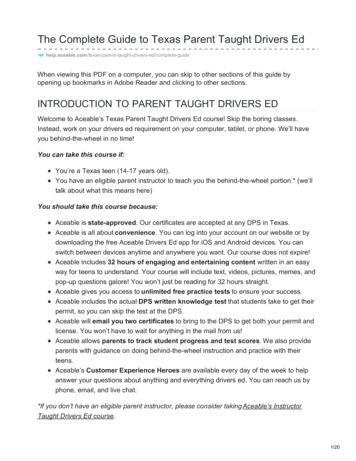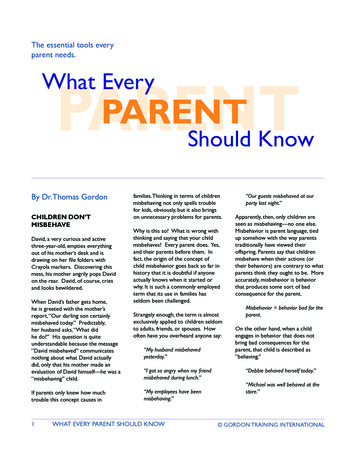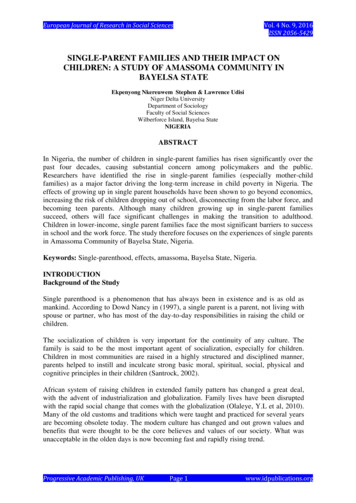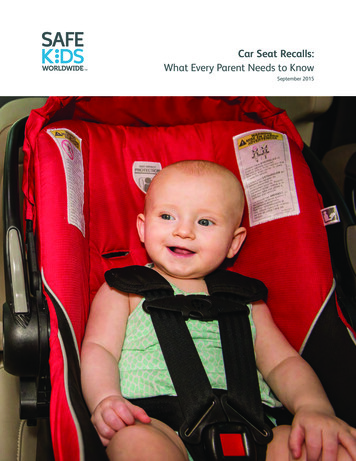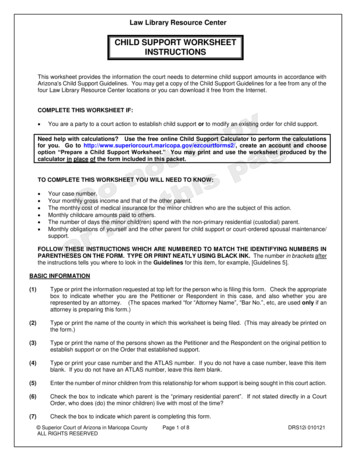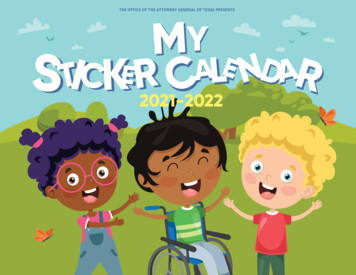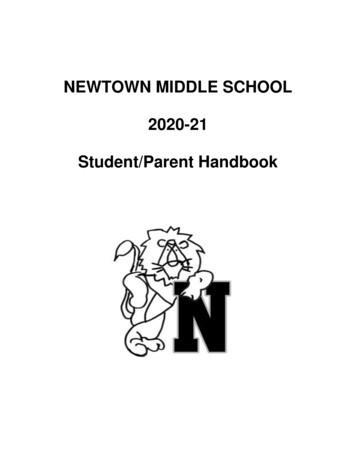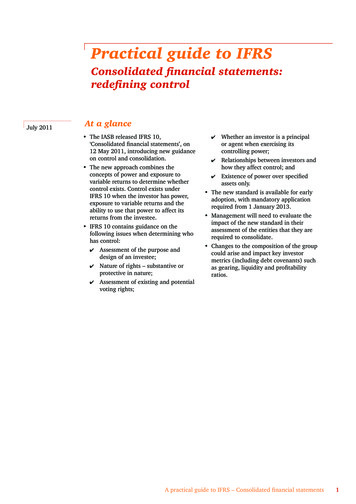
Transcription
What Every Parent Needs toKnow about AppliedBehavior Analysis (ABA)David F. Bicard, Ph.D., BCBA-DEsther Plank, MS
Know Your Rights Six Major Principles of The Individuals withDisabilities Education ACT (IDEA) IDEA is the law that schools must follow foreducating students with disabilities
Zero Reject Schools must educating ALL children withdisabilities This principle applies regardless of the nature orseverity of the disability Schools cannot refuse to educate a student withdisabilities simply because they don’t offer theservices Services begin AT AGE 3 in states that providesservices to children without disabilities (includingTN)
Nondiscriminatory Identificationand Evaluation Schools must use non-biased, multifcatoredmethods of evaluation to determine whethera child has a disability Identification and placement cannot bebased on a SINGLE test score
Free and Appropriate Education-(FAPE) All children with disabilities, regardless oftype or severity shall receive FAPE withoutcost to the parents All children with disabilities must receive anindividualized education program (IEP) The IEP specifies the child’s unique educationalneeds and states the goals and objectives ofteaching for at least one school year
Least Restrictive Environment All students should be educated to thegreatest extent possible with children withoutdisabilities Students with disabilities should havecontinuum of placement options
Parent and Student Participation andShared Decision Making Schools must collaborate with parents andchildren with disabilities in the developmentof the child’s IEP
Due Process Safeguards If the parent and school cannot agree on aplan for the student’s education the parent isentitled to a hearing by an impartial thirdparty School districts must pay attorney’s fees ifthe hearing officer rules in favor of theparents
ABA Definition “ABA is the science in which procedures derived from theprinciples of behavior are systematically applied to improvesocially significant behavior to a meaningful degree and todemonstrate experimentally that the procedures employedwere responsible for the improvement in behavior” (Baer,Wolf, & Risley, 1968).
What is ABA? Applied Behavior Analysis (ABA) A science– An organized body of knowledge discovered through the processof objective observation, measurement, and evaluation– Journal of Applied Behavior Analysis, Journal of BehavioralEducation, Journal of Precision Teaching, Journal of theExperimental Analysis of Behavior A practice– A method of applying the principles of behavior to understand andimprove important human behavior– The practice of ABA has been an ongoing effort for over 40 years
Behaviorism The philosophy of the science ofbehavior analysis A behaviorist believes that theinteraction between the environmentand behavior is the most importantsubject matter when studying behavior– A behaviorist does not invent hypotheticalconstructs as causal mechanisms forbehavior
Mentalism Is the philosophy behind many branches of thescience of psychology Assumes mental or inner states exist that are differentfrom observable behavior These mental states are causes of or mediators ofbehavior Mental states are used to explain behavior– These are called explanatory fictions»She hand-flaps because she is autistic.
Behaviorism and Mentalism In behaviorism the subject matter is behavior Behaviorism uses observable interactions with the environment to explainbehavior– Some examples Positive reinforcement Negative reinforcement Type I punishment In mentalistic sciences the subject matter is often behavior but not always Mentalism uses hypothetical constructs to explain behavior– Some example of hypothetical constructs Cognitive mapsSchemaIntelligenceNeural networksLearning stylesDisability label
Behaviorism and Mentalism Behavioral explanation The child found the candy bar under the desk easily because acandy bar was there yesterday and she saw it. Mentalistic explanation The child used her cognitive map and schema of the situation to findthe candy bar under the desk. Cognitive maps and schema cannot be measured normanipulated, rather they are inferred from the observation ofobservable behavior There is no way to determine that a cognitive map or schema exists Even if they do exist there is no way to affect them
Behaviorism Over 50 years of research has verified that the principles of behavior areuniversal and have many applications to every day problems. Behaviorists try to avoid circular reasoning. If a child has a normal IQ and his achievement is low he has alearning disability. How do we “know”? He has normal IQ and lowachievement– The problem is placed somewhere within the child The problem is inaccessible and cannot be changed Behaviorism and ABA are very optimistic. (It’s not that the student can’tlearn, but it is that we haven’t found the right learning conditions)
Behavior Analysis Three Branches Conceptual Analysis of Behavior– Focus on theoretical or conceptual issues Experimental Analysis of Behavior– Focus on discovering basic principles of behavior– Research done in a laboratory environment with both humans and nonhumans Applied Behavior Analysis– Focus on discovering and clarifying functional relations between sociallysignificant behavior and its controlling variables– Research done in “real world” environments with humans
Behavioral Technology Services derived from the principles ofbehavior that have been tested and shown tobe effective on socially significant behavior Mental health servicesEducational servicesProfessional development in businessConsumer and occupational safety
Behavioral Technology The focus of behavioral technology Applying research tested methods to improve the lives of the peopleserved Quality Indicators Behavior(s) prioritized and targeted for improvement by theirimportance to the individual Procedures derived from published research Procedures delivered consistently across practitioners Direct and frequent measurement of the behavior(s) of interest Data based decision making Procedures produce meaningful change in behavior
Practice of g Research testedteaching methodsDiscrete TrialTeachingSpecialDiets Frequentmeasurement ofperformance Data based decisionmaking based onbehavioral r TimeVerbalBehaviorMethodChelationTherapyABA can be used todetermine if thesemethods improvebehavior
History of ABA Applied behavior analysis (ABA) began in the1950s when researchers applied theprinciples of behavior to improve sociallysignificant behaviors. The Journal of Applied Behavior Analysis (JABA)was first published in 1968. In the first issueBaer, Wolf, & Risley published a landmark paperdefining ABA.
ABA is Not Coercive It is unethical and scientifically unwise to force children to do thingsthey don’t want to Just used to eliminate bad behavior For any behavior targeted for reduction there must also be afunctional replacement taught Bribery Bribery is an illicit payment for an illegal action Only for children with Autism The procedures derived from the study of behavior have universalapplication
ABA is Not Going to teach children to become robots Studies have shown that ABA is effective for teachingspontaneous and creative behavior Just discrete trial training ABA is more than just an instructional method Easy ABA promises no easy fixes or cures, just hard work andattention to detail with a focus on small but importantchanges on a daily basis A new fad in education Almost 50 years of research showing improvements inimportant behaviors
What Does a Behavior AnalystDo? Uses the tools of science to determine howthe environment affects behavior Provides individualized behavioralassessments and interventions for children,adolescents, and adults Interventions based on analysis of theenvironment
Terms and What they Mean Discrete Trial A teaching episode that includes an instructionalcue/question, a student response, and aconsequence Lovaas Method Discrete trial teaching based on Dr. Ivor Lovaas’sresearch PECS Picture exchange communication systems– A form of communication where icons or pictures areexchanged for activities (bathroom) or tangibles (cookies)
Terms and What they Mean Verbal Behavior Method A particular method of practice in which students are firsttaught to request things Reinforcement A consequence that increases the future occurrence of abehavior Mand A request Tact A label Intraverbal conversation
Important steps indeveloping a homeprogram
The Consultant/Supervisor A Board Certified Behavior Analyst (BCBA) At least a Master’s degree in Behavior Analysisor a related area 225 hours of graduate level coursework inspecific behavior analytic content areas 1500 hours of supervised experience indesigning and implementing applied behavioranalysis interventions A passing score or standardized exam
The Consultant/Supervisor Should have a least one year experience inproviding ABA services directly to childrenand/or adults with ASD. Should also have experience with bothgeneral and special education.
The Consultant/Supervisor Attending or giving some workshops, takingsome courses, or getting brief hands-onexperience does NOT qualify an individual topractice Applied Behavior Analysis effectivelyand ethically. Unfortunately, there may be some individualswho misrepresent themselves in this manner.
A Consultant will: Set up the curriculum for your child’s program Visit different settings to observe your child Identify areas of need (i.e., self-help skills,socialization skills, etc.) Hold and manage meetings to discuss yourchild’s specific needs with all of the team Train therapists on techniques for dealing theproblem behaviors
Therapists/Home trainers Will be trained by consultant supervisors Can be college students (special education,child development, psychology, ABA, etc.),teachers assistants, substitute teachers, etc. Should have experience in fields related tochildren with special needs Should understand the program principlesand have experience providing ABA services
When hiring therapists: Ask questions! Be clear about expectations Discipline Documentation Hours Get references
Documentation Documentation of your in-home program iscrucial! Documentation should be: GraphsFor each task or drillRecorded in the same manor by each therapistReviewed regularly by the BCBA for accuracy,task completion, and for moving the programforward
Regular team meetings Should occur at least once a month andpreferably more often than that Help to adjust, add, or delete activities in theprogram Help to troubleshoot any problems of theteam Should review behaviors, learning issues,drills, social skills and play skills, and anychild, parent, or therapist issues
Your home program should: Have the following components: A list of target skills to teachTechniques on how to teach each target skillMaterials needed to teachProbe sheets for data collectionGraphs for data analysis Extinguish and minimize problem behaviorsand increase appropriate behaviors
Your home program should: Get your child ready to learn By teaching basic academic concepts andbuilding on these as the child progresses Supplement the school programs to meet yourchild’s goals Incorporate prompting, error correction,reinforcement, stimulus control, preferenceassessments, and choice procedures in skillbuilding drills.
Your home program should: Incorporate events like going to the park,going to a birthday party, or playing in thebackyard into learning experiences for yourchild. Be constantly changing and growing withyour child.
Your Questions
What Every Parent Needs to Know about Applied Behavior Analysis (ABA) David F. Bicard, Ph.D., BCBA-D Esther Plank, MS. Know Your Rights Six Major Principles of The Individuals with Disabilities Educatio
